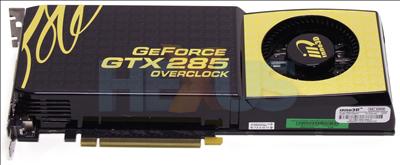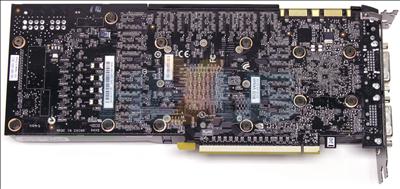Card appearance and thoughts
GeForce GTX 285Please head on over to our GeForce GTX 285 review for an in-depth analysis of what the new card brings to the table. We also compare it against six other cards in the performance look, just so you know where it stands in relation to the competition.
Reducing the analysis massively, GTX 285 is literally the same as the erstwhile single-GPU performance-leader from NVIDIA, albeit with faster clocks of 648MHz/1,476MHz/2,484MHz for the core, shader and memory, respectively, compared to 612MHz/1,242MHz/2,214MHz for GTX 280.
There's also a little core-to-core difference between the two, insofar as NVIDIA claims to have 'cleaned-up' parts of the GPU to make it slightly faster on a per-clock basis. Put simply, GTX 285 is better in every way, being quicker and quieter, and that's why partners will reduce GTX 280 inventory levels and ramp up distribution of the new part, based on a 55nm process.
Inno3D will retail a stock-clocked part, but such is the frequency headroom on the new process, that a pre-overclocked model, dubbed OVERCLOCK, is also being released immediately.
Apart from some fancy graphics, there isn't much to differentiate this card from any other GeForce GTX 285, or, indeed, GTX 280.
However, Inno3D bumps up clocks to 700MHz core (+8%), and 2,560MHz (+3%) for the memory, but, annoyingly, the shader speed is kept the same, at 1,476MHz. This very fact will count against it when compared to other pre-overclocked GTX 285s.
The card draws around 215W under load, some 20W or so below a GTX 280. It's also quieter than the previous card, although that was no dustbuster, either.
It frequency-throttles down to 300MHz core and 200MHz memory when in 2D mode, and you would do well to hear it in a quiet system.
A slight reduction in power-draw means that the GTX 285 now uses dual six-pin power-connectors, rather than the six- and eight-pin on you know what. As Tesco says, 'every little helps'.
Twin dual-link DVI and mini-DIN for TV-out are NVIDIA favourites, and the company has yet to match ATI's through-motherboard audio routing. Rather, there's a S/PDIF input on one side, which can be used to push audio from motherboard and out via a DVI-to-HDMI dongle. But you probably won't be considering buying a GTX 285 based on its pure multimedia capabilities, right?
The 1GB's worth of memory chips are located on the front of card, with each 128MB DRAM connected up to a ROP partition.
GeForce GTX 285 supports the usual GeForce features such as two- and three-way SLI, PhysX, CUDA, and, now GeForce 3D Vision, too.














